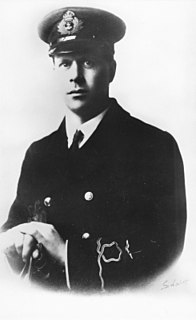
Ultralight aviation is the flying of lightweight, 1- or 2-seat fixed-wing aircraft. Some countries differentiate between weight-shift control and conventional 3-axis control aircraft with ailerons, elevator and rudder, calling the former "microlight" and the latter "ultralight".

The Avro Lancaster is a British four-engined Second World War heavy bomber. It was designed and manufactured by Avro as a contemporary of the Handley Page Halifax, both bombers having been developed to the same specification, as well as the Short Stirling, all three aircraft being four-engined heavy bombers adopted by the Royal Air Force (RAF) during the same wartime era.
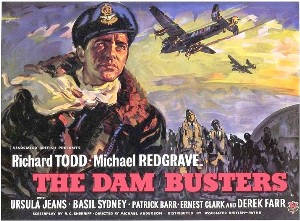
The Dam Busters is a 1955 British epic war film starring Michael Redgrave and Richard Todd. It was directed by Michael Anderson. The film recreates the true story of Operation Chastise when in 1943 the RAF's 617 Squadron attacked the Möhne, Eder, and Sorpe dams in Nazi Germany with Barnes Wallis's bouncing bomb.
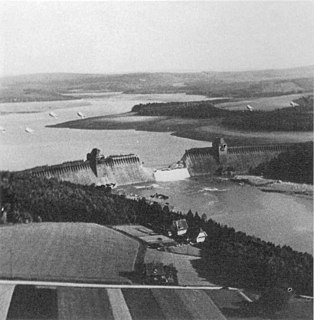
Operation Chastise was an attack on German dams carried out on 16–17 May 1943 by Royal Air Force No. 617 Squadron, later called the Dam Busters, using a purpose-built "bouncing bomb" developed by Barnes Wallis. The Möhne and Edersee Dams were breached, causing catastrophic flooding of the Ruhr valley and of villages in the Eder valley; the Sorpe Dam sustained only minor damage. Two hydroelectric power stations were destroyed and several more damaged. Factories and mines were also damaged and destroyed. An estimated 1,600 civilians – about 600 Germans and 1,000 mainly Soviet forced labourers – died. Despite rapid repairs by the Germans, production did not return to normal until September.

Wing Commander Guy Penrose Gibson, was a distinguished bomber pilot in the Royal Air Force during the Second World War. He was the first Commanding Officer of No. 617 Squadron, which he led in the "Dam Busters" raid in 1943, resulting in the destruction of two large dams in the Ruhr area of Germany. He was awarded the Victoria Cross, the highest award for gallantry in the face of the enemy that can be awarded to British and Commonwealth forces, in the aftermath of the raid in May 1943 and became the most highly decorated British serviceman at that time. He completed over 170 war operations before dying in action at the age of 26.

The de Havilland DH.82 Tiger Moth is a 1930s British biplane designed by Geoffrey de Havilland and built by the de Havilland Aircraft Company. It was operated by the Royal Air Force (RAF) and many other operators as a primary trainer aircraft. In addition to the type's principal use for ab-initio training, the Second World War saw RAF Tiger Moths operating in other capacities, including maritime surveillance and defensive anti-invasion preparations; some aircraft were even outfitted to function as armed light bombers.

The Vickers Wellesley was a British 1930s light bomber built by Vickers-Armstrongs at Brooklands near Weybridge, Surrey, for the Royal Air Force. While it was obsolete by the start of the Second World War and unsuited to the European air war, the Wellesley was operated in the desert theatres of East Africa, Egypt and the Middle East. It was one of two planes named after Arthur Wellesley, 1st Duke of Wellington, the other being the Vickers Wellington.

The Indian nightjar is a small nightjar which is a resident breeder in open lands across South Asia and Southeast Asia. Like most nightjars it is crepuscular and is best detected from its characteristic calls at dawn and dusk that have been likened to a stone skipping on a frozen lake - a series of clicks that become shorter and more rapid. They are sometimes spotted on roads when their eyes gleam red in the spotlight of a vehicle. There is considerable plumage variation across its range and can be hard to differentiate from other nightjars in the region especially in the field.

A bouncing bomb is a bomb designed to bounce to a target across water in a calculated manner to avoid obstacles such as torpedo nets, and to allow both the bomb's speed on arrival at the target and the timing of its detonation to be pre-determined, in a similar fashion to a regular naval depth charge. The inventor of the first such bomb was the British engineer Barnes Wallis, whose "Upkeep" bouncing bomb was used in the RAF's Operation Chastise of May 1943 to bounce into German dams and explode underwater, with effect similar to the underground detonation of the Grand Slam and Tallboy earthquake bombs, both of which he also invented.
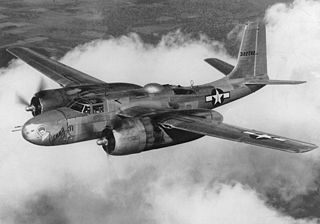
The Douglas A-26 Invader is an American twin-engined light bomber and ground attack aircraft. Built by Douglas Aircraft Company during World War II, the Invader also saw service during several major Cold War conflicts. A limited number of highly modified United States Air Force aircraft served in Southeast Asia until 1969. It was a fast aircraft capable of carrying a large bomb load. A range of guns could be fitted to produce a formidable ground-attack aircraft.

The Bristol Bulldog was a British Royal Air Force single-seat biplane fighter designed during the 1920s by the Bristol Aeroplane Company. More than 400 Bulldogs were produced for the RAF and overseas customers, and it was one of the most famous aircraft used by the RAF during the inter-war period.

Tallboy, or Bomb, Medium Capacity, 12,000 lb, was an earthquake bomb developed by the British aeronautical engineer Barnes Wallis and used by the RAF during the Second World War.

The Grand Slam was a 22,000 lb (10,000 kg) earthquake bomb used by RAF Bomber Command against strategic targets during the Second World War.

No. 10 Squadron is a Royal Australian Air Force (RAAF) maritime patrol squadron based at RAAF Base Edinburgh, South Australia, as part of No. 92 Wing. The squadron was formed in 1939 and saw active service during the Second World War, conducting anti-submarine operations and patrols from bases in the United Kingdom until it disbanded in late 1945. It was re-formed in Australia in 1949 and since then has contributed to Australia's East Timor intervention, and has been deployed to the Middle East as part of the War on Terrorism and the 2003 Gulf War.

No. 9 Squadron was a unit of the Royal Australian Air Force (RAAF). The squadron was formed in early 1939 and saw active service in World War II as a fleet co-operation unit providing aircrews for seaplanes operating off Royal Australian Navy cruisers. It was disbanded in late 1944, but was re-raised in 1962 and later became an Army co-operation unit, flying helicopters in support of Australian troops during the Vietnam War. The squadron was disbanded in 1989 when the RAAF transferred its battlefield helicopters to the Australian Army's aviation regiments.

The Northrop F-15 Reporter was an American unarmed photographic reconnaissance aircraft. Based on the Northrop P-61 Black Widow night fighter, it was the last piston-powered photo-reconnaissance aircraft designed and produced for the United States Air Force. Though produced in limited quantities, and with a relatively short service life, the F-15's aerial photographs of the Korean Peninsula would prove vital in 1950, when North Korea invaded the south.
No 36 Squadron of the Royal Flying Corps was formed at Cramlington in 1916 and was disbanded for the last time in 1975.

The Westland Wallace was a British two-seat, general-purpose biplane of the Royal Air Force, developed by Westland as a follow-on to their successful Wapiti. As the last of the interwar general purpose biplanes, it was used by a number of frontline and Auxiliary Air Force Squadrons. Although the pace of aeronautical development caused its rapid replacement in frontline service, its useful life was extended into the Second World War with many being converted into target tugs and wireless trainers. In 1933 a Westland Wallace became the first aircraft to fly over Everest, as part of the Houston-Mount Everest Flight Expedition.
Charles Seaton Cockell is a British astrobiologist who is the current professor of astrobiology in the School of Physics and Astronomy at the University of Edinburgh and Director of the UK Centre for Astrobiology.. He was previously the Professor of Geomicrobiology with the Open University and a microbiologist with the British Antarctic Survey, Cambridge, UK. His scientific interests have focused on astrobiology, geomicrobiology and life in extreme environments. He has published over 300 scientific papers and books in these areas. He has contributed to plans for the human exploration of Mars. For example, he led the design study Project Boreas, which planned and designed a research station for the Martian polar ice caps. He was the first Chair of the Astrobiology Society of Britain.
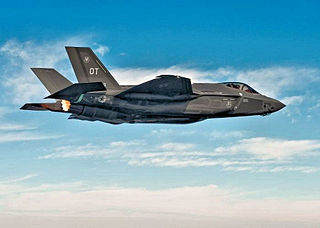
The 422d Test and Evaluation Squadron is a United States Air Force unit. It is assigned to the 53d Test and Evaluation Group, stationed at Nellis Air Force Base, Nevada. The squadron performs operational testing of all fighter aircraft and munitions entering and in operational use by Air Combat Command.


